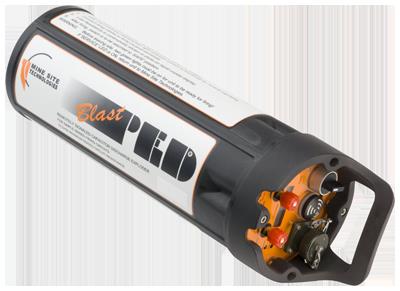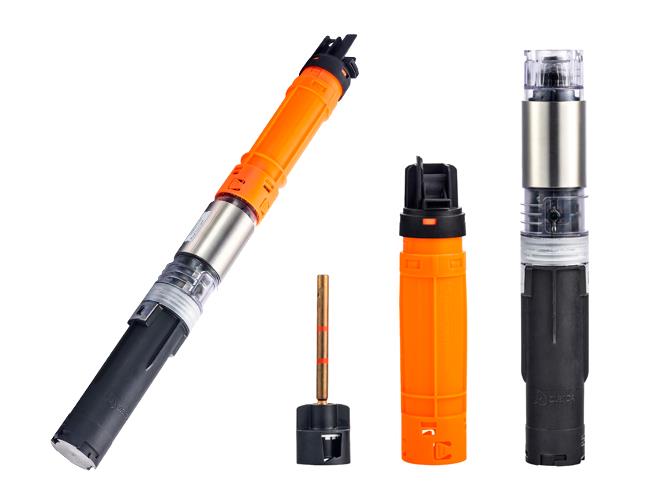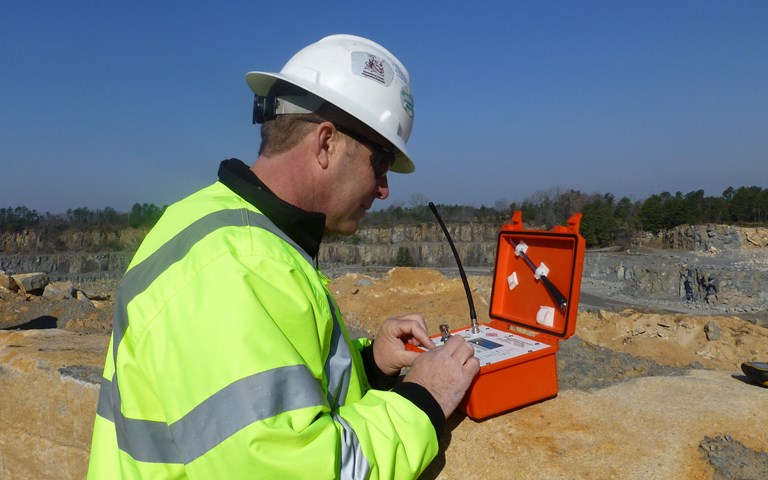Last year, Austin Powder launched a new version of its E*Star wireless remote firing system. Courtesy of Austin Powder
The move toward wireless blasting has been less than explosive. When Austin Powder Company – an industrial explosives manufacturer – released the pilot version of its E*Star wireless electronic blasting machine in 2006, adoption was slow. For four years the E*Star remained in limited use before it began to eventually catch on.
“As the use and applications of the remote part of the firing system started to widen and broaden, the need to be able to fire wirelessly became more and more of a customer request,” said Bryan Papillon, Austin Powder’s director of e-technology.
Mining companies were increasingly looking for ways to enhance safety while also cutting costs. By eliminating the wire connecting the blast to the blasting machine, which is located nearer the blast site, and communicating with it remotely via radio instead, mine personnel could stay a greater and thus a safer distance from the blast, and companies could also save on the trouble and expense of single-use copper wiring.
Initially, Austin Powder built a wireless firing system that possessed two-way radio communication capabilities with the blasting machine, but had minimal ability to display to the blaster in charge what state the blasting machine was in during the diagnostic and firing process.
In 2015, the company introduced a completely new version of the E*Star Wireless Remote Firing system that automatically switches off the blasting machine after the blast is complete. This wireless remote firing system can also be configured to operate in conjunction with an underground mine’s leaky feeder radio communication system.
“That sounds like a small feat now that it’s done, but that was a major challenge,” Papillon said. It took the company two years to complete the proper fault-proofing, testing and validation necessary to ensure that what they developed was in fact a safer system.
With the challenge of remote blasting machines now solved, innovation is currently working its way into the blast hole. Microchip-equipped electronic detonators, with their impressive timing and precision, re-invented blasting when they were introduced 15 years ago. To initiate the blast though, a wired connection between the blasting machine and the detonator was still needed.
However, in fall 2015, Orica – the largest global supplier of commercial explosives and blasting systems to the mining industry – announced that it had developed the world’s first commercially viable wireless through-the-rock blasting system.
“We have had various remote blasting systems for our wired i-kon electronic blasting system for years,” said Steve Piercey, underground blasting specialist at Orica.
“This is taking it to the next level. There are no wires whatsoever to connect.”

MST Global adapted through-the-earth technology, initially designed as an emergency communication system, to simplify underground blasting. Courtesy of MST Global
In sub-level caving, for example, there will be no requirement for miners to work near the brow to prepare the next blast. Normally, workers can spend considerable time hooking-up several kilometres of wires to thousands of detonators in preparation for a blast manually. The resulting hook-up forms a spider-web-like network of wires leading from the blasting machine to the detonators inside the drill hole.
According to David Proudfoot, senior electronic blasting system specialist at Orica, eliminating the wires from a blasting operation eliminates most of the problems miners experience.
“Anytime you’ve made a blast you’ve created a certain amount of destabilization in the geology of the ground,” Proudfoot said. “If you could load up a series of blasts and fire them without putting people in harm’s way to go back in to reconnect the wires, then you’ve improved the safety of that operation. This could lead to changing the mining sequence of that operation.”
Connecting Through-The-Earth
The concept of through-the-rock communication is well established. MST Global, a communications technology infrastructure and applications development company, pioneered the use of Through-The-Earth (TTE) technology 26 years ago with its PED Emergency Warning System.
TTE is a one-way communication system that connects with devices underground by emitting ultra-low frequency radio wave signals that penetrate solid rock at depths of 800 to1000 metres. By installing a loop antenna either at the surface or underground, messages entered from a remote location on the surface are displayed as text messages on Caplamp receivers carried by miners underground.
Initially developed as a messaging system to alert miners in the case of an emergency, TTE soon spread to other applications throughout the mine, like remote equipment control.
It was not long before MST Global figured out how to use TTE for remote blasting. In 1995, the company installed the first BlastPED for use in underground environments. Messages sent from a computer at the surface were transmitted through an RS 232 connection to a PED Modulator equipped with emergency message buttons. Traveling through a hard wire or fibre optic link to a PED ULF transmission headend, the message would connect to the PED loop antenna – which can be installed either above or below ground – before being transmitted via ultra-low frequency signals through the earth to the BlastPED device.
“It really simplified the whole process of how you can blast underground,” said Mike Foletti, general manager of business development at MST Global.
With a 99 per cent success rate, Foletti said that BlastPED quickly became the standard method for blasting in underground Australian hard rock mines.
In 1998, Stillwater Mining approached MST Global to help it develop a wireless blasting system at its platinum mine in south-central Montana, next to Yellowstone National Park.
The topography around the mine meant that it was not viable to actually lay a loop antenna on the surface or underground. To get around this problem, MST Global adapted the BlastPED for use on leaky feeder communication systems.
“They had an existing leaky feeder system in place that they maintained because it supported their communications, so instead of using a PED receiver device that picked up a signal from a loop antenna, we basically picked up the signal from the leaky feeder which provided the communications for the blast initiation,” Foletti explained.
Cutting the cord
As it turned out, having a detonator without wires was not too difficult to conceive of. Initiating a blast without a wired connection proved to be the biggest challenge.

The wireless primer developed by Orica, shown here both assembled and in parts, combines an antenna, communication electronics, electronic detonator and a booster. Courtesy of Orica
“There was a period where our thoughts were running fast but the technology wasn’t there,” Proudfoot said.
After nine years of development – which required the collaboration of about 200 people spread across the globe – Orica is almost ready to roll out a commercial version of the fully wireless blasting system.
The 19-inch-long cylindrical device is two inches in diameter, which is smaller than the initial prototype but still larger than what Piercey imagines it will be once the technology is further developed.
Using electromagnetic induction, the wireless, through-the-rock initiation system contains a three-axis antenna, battery and electronics, as well as a specially modified i-kon II detonator with unique connection terminals that are enclosed in a special booster. Delay times are assigned with an encoder that connects via an optical communications port, and the unit can be held in place using a tether lock at the end. The units can “sleep” in the loaded hole for up to six months before they are called upon to do their job in the blast sequence.
Initiating requires a unique ultra-low frequency wavelength by which the surface personnel will communicate with the wireless, through-the-rock initiation system through as much as 1,000 metres of solid rock, and all communications are 64-bit encrypted.
Piercey asserted that the wireless, through-the-rock blasting system is as revolutionary as the cell phone, which began bulky and expensive but has since been refined. “A smaller unit will be a true enabler in the quest for automated development drilling and blasting,” he said.
While he is tremendously excited about the company’s technology, Piercey concedes that it might be a while before it becomes the new norm for electronic blasting. There are many day-to-day blasting operations for which this technology is not suited. Yet, at the same time, it opens the door to re-imagine what the day-to-day might look like in the future, explained Piercey. “It gets really exciting when you think about mining methods and extraction sequences and start to ask ‘are there different ways we can do things?’’’






